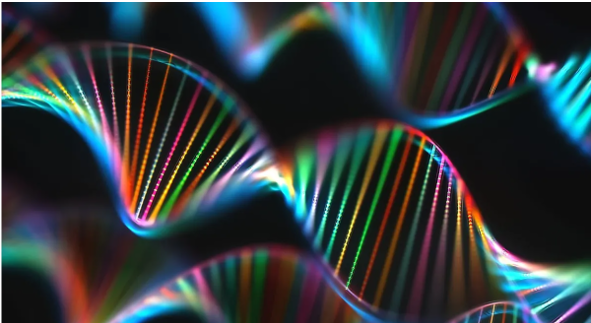Breakthrough: Artificial DNA opens the door to designer proteins
Researchers used a synthetic DNA system called AEGIS to design two artificial nucleotides that flawlessly mimic the geometry of natural nucleotides.
by Rizwan Choudhury Published: Dec 17, 2023 08:02 AM EST

Concept image of genetic codes in DNA. ktsimage/iStock
DNA, the molecule that stores the genetic information of all living things, is made up of just four chemical letters, or nucleotides. But what if we could add more letters to this alphabet and create new kinds of DNA?
That's what a team of researchers from the University of California San Diego, the Foundation for Applied Molecular Evolution, and the Salk Institute for Biological Studies have done. They have developed a new version of DNA with six letters instead of four, showing that it can be used to make proteins, the building blocks of life.
This feat, published in Nature Communications, opens doors to a future where custom-designed proteins and novel biological applications could become a reality.
Four nucleotides
DNA, the blueprint of life, encodes its instructions using just four nucleotides – adenine (A), thymine (T), guanine (G), and cytosine (C). These nucleotides pair in specific configurations, forming the iconic double helix. But what if this alphabet could be expanded? The implications are compelling, ranging from personalized medicine to revolutionary materials.
"Life on Earth is amazingly diverse with just four nucleotides, so imagine what we could do with more," said Dong Wang, Ph.D., a professor at Skaggs School of Pharmacy and Pharmaceutical Sciences at UC San Diego and the senior author of the study.
"By expanding the genetic code, we could create new molecules that have never been seen before and explore new ways of making proteins as therapeutics."
Wang and his colleagues used a synthetic DNA system called AEGIS, which stands for Artificially Expanded Genetic Information System. AEGIS was created by Steven A. Benner, PhD, at the Foundation for Applied Molecular Evolution, as part of a NASA-funded project investigating how life could have evolved in other planets.
Dr. Dong Wang aptly describes that adding new 'letters' to the genetic code expands the vocabulary of life, allowing us to write more complex narratives." His team's breakthrough demonstrates that cells can readily incorporate synthetic nucleotides into the DNA recipe.
Using AEGIS
AEGIS adds two new letters to the standard DNA alphabet, which consists of adenine (A), thymine (T), guanine (G), and cytosine. These letters pair up in a specific way to form the double-helix structure of DNA, which was discovered by James Watson and Francis Crick in 1953.
The new letters, Z and P, have the same shape and size as the natural ones, so they can fit into the DNA helix without disrupting its geometry. This means that the enzymes that read and copy DNA, such as RNA polymerase, can recognize and process AEGIS DNA just like natural DNA.
RNA polymerase
The key lies in mimicking nature's machinery. The researchers identified RNA polymerase, a key enzyme that converts DNA into RNA, which is then used to make proteins. They designed two artificial nucleotides that flawlessly mimic the geometry of natural nucleotides. RNA polymerase readily accepted these novel additions when tested, seamlessly incorporating them into transcription.
The researchers tested whether RNA polymerase from bacteria could transcribe AEGIS DNA into RNA and found that it could do so with high accuracy and efficiency.
"This is a remarkable demonstration of how robust and adaptable the biological machinery is," said Wang. "By mimicking the natural shape of DNA, our synthetic letters can sneak in and be used to make new proteins."
This breakthrough paves the way for exciting possibilities. Imagine designing proteins with tailor-made properties capable of precisely targeting tumors for cancer therapy or engineering bacteria to synthesize eco-friendly biofuels. The vast horizons extend beyond medicine and environmental applications to materials science and potentially even synthetic biology.
Of course, challenges remain. Optimizing the incorporation of new nucleotides, ensuring their stability within the genome, and deciphering the full potential of this expanded code are areas for further exploration. Yet, the foundation for rewriting the genetic lexicon has been laid.
This discovery signifies a momentous leap in our understanding of life's blueprint. It holds the promise of ushering in a new era of biological design, where the possibilities are limited only by our imagination.
"These new proteins could have applications in medicine, biotechnology, and bioengineering," said Wang. "We are only scratching the surface of what we can do with artificial DNA."
Study abstract:
Artificially Expanded Genetic Information Systems (AEGIS) add independently replicable unnatural nucleotide pairs to the natural G:C and A: T/U pairs found in native DNA, joining the unnatural pairs through alternative modes of hydrogen bonding. Whether and how AEGIS pairs are recognized and processed by multi-subunit cellular RNA polymerases (RNAPs) remains unknown. Here, we show that E. coli RNAP selectively recognizes unnatural nucleobases in a six-letter expanded genetic system. High-resolution cryo-EM structures of three RNAP elongation complexes containing template-substrate UBPs reveal the shared principles behind the recognition of AEGIS and natural base pairs. In these structures, RNAPs are captured in an active state, poised to perform the chemistry step. At this point, the unnatural base pair adopts a Watson-Crick geometry, and the trigger loop is folded into an active conformation, indicating that the mechanistic principles underlying recognition and incorporation of natural base pairs also apply to AEGIS unnatural base pairs. These data validate the design philosophy of AEGIS unnatural base pairs. Further, we provide structural evidence supporting a long-standing hypothesis that pair mismatch during transcription occurs via tautomerization. Together, our work highlights the importance of Watson-Crick complementarity underlying the design principles of AEGIS base pair recognition.
